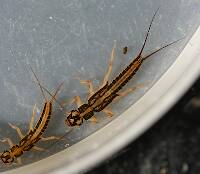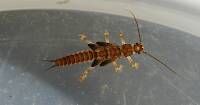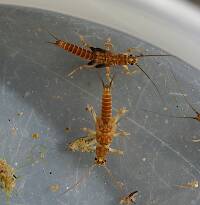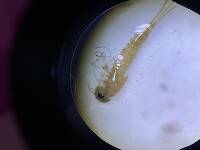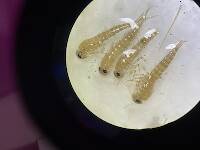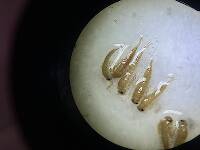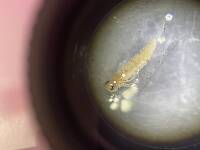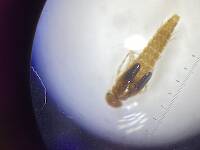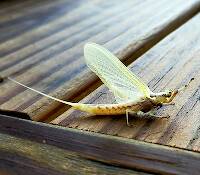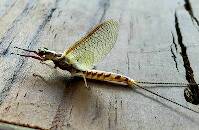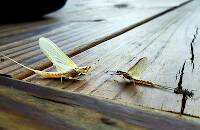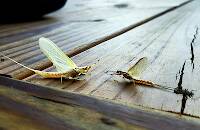
Hex Mayflies
Hexagenia limbata
The famous nocturnal Hex hatch of the Midwest (and a few other lucky locations) stirs to the surface mythically large brown trout that only touch streamers for the rest of the year.
Featured on the forum

Nymphs of this species were fairly common in late-winter kick net samples from the upper Yakima River. Although I could not find a key to species of Zapada nymphs, a revision of the Nemouridae family by Baumann (1975) includes the following helpful sentence: "2 cervical gills on each side of midline, 1 arising inside and 1 outside of lateral cervical sclerites, usually single and elongate, sometimes constricted but with 3 or 4 branches arising beyond gill base in Zapada cinctipes." This specimen clearly has the branches and is within the range of that species.

Troutnut is a project started in 2003 by salmonid ecologist Jason "Troutnut" Neuswanger to help anglers and
fly tyers unabashedly embrace the entomological side of the sport. Learn more about Troutnut or
support the project for an enhanced experience here.
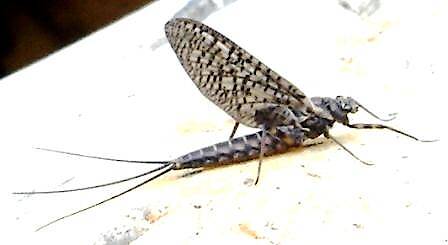
Boerie on Feb 9, 2008February 9th, 2008, 10:18 pm EST
Its about 14mm in length (excl tails)
Any ideas?
Any ideas?
Piscator Non Solum Piscator
Taxon on Feb 12, 2008February 12th, 2008, 11:34 pm EST
Yuri-
Yes, but not necessarily a good one. To me, it looks a lot like Ameletus. However, the fly in the ointment is that they have only two tails in their winged lifestages. Is it possible the (apparent) 3rd tail in your photo is a shadow from one of the other two?
Yes, but not necessarily a good one. To me, it looks a lot like Ameletus. However, the fly in the ointment is that they have only two tails in their winged lifestages. Is it possible the (apparent) 3rd tail in your photo is a shadow from one of the other two?
Boerie on Feb 13, 2008February 13th, 2008, 5:16 am EST
Unfortunately not. This one has three tails.
Thanks though - will do some research on that one though.
I haven't heard anything from the Mayfly experts yet.
Thanks though - will do some research on that one though.
I haven't heard anything from the Mayfly experts yet.
Piscator Non Solum Piscator
Troutnut on Feb 14, 2008February 14th, 2008, 8:14 pm EST
That's a puzzle. Have you got any larger version of the picture you could post, or any other pictures from other angles?
Of the mayflies I'm familiar with, it most closely resembles Ephemera, but the shape just doesn't look quite right. I'm guessing it's some more obscure taxon, possibly unique to Eurasia. Where did you collect it exactly, and at what time of year?
Any more information you can provide might help.
Of the mayflies I'm familiar with, it most closely resembles Ephemera, but the shape just doesn't look quite right. I'm guessing it's some more obscure taxon, possibly unique to Eurasia. Where did you collect it exactly, and at what time of year?
Any more information you can provide might help.
Jason Neuswanger, Ph.D.
Troutnut and salmonid ecologist
Troutnut and salmonid ecologist
Boerie on Feb 15, 2008February 15th, 2008, 10:03 pm EST
It was photographed in South Africa on a western Cape river called the Holsloot.
It might be a pronggill(Leptophlebiidae),or more likely a brushgill (Oligoneurdae).
It was photographed in October, which is early summer for SA.
Unfortunately there are no other photographs worth posting.
It might be a pronggill(Leptophlebiidae),or more likely a brushgill (Oligoneurdae).
It was photographed in October, which is early summer for SA.
Unfortunately there are no other photographs worth posting.
Piscator Non Solum Piscator
Troutnut on Feb 16, 2008February 16th, 2008, 6:14 am EST
I kind of doubt it's Leptophlebiidae, because they don't have such mottled wings. At least not the genera I'm familiar with. It's possible, but unlikely, that a South African genus in that family might have mottled wings while the North American genera do not.
I doubt it's Oligoneuridae, because they're supposed to have this characteristic venation:
This certainly doesn't fit that characteristic, which I found photographed here. However, that characteristic is from a North American key, so it might be unique to the small number of North American species, and perhaps African Oligoneuridae don't share that trait. It seems unlikely, but it's possible.
According to Roger's website, the adults of one North American Oligoneurid, Lachlania, have just two tails. Usually that's a consistent number throughout a family, but I'm not positive it's always the case. But it seems like a strike against that guess.
I found a page listing the mayflies of South Africa.
It seems there aren't a lot of options other than what you guessed. Heptageniidae might make sense, except that it has 3 tails, and they don't. There are two families in the superfamily Ephemerelloidae that I've never heard of, so I wouldn't rule them out, but it just doesn't quite have the "look" of that group. I also wouldn't rule out Ephemeridae, but again the "look" isn't quite right. Other than those, the two families you suggested are the only viable options.
I'm really stumped. If I had to guess right now, I'd guess that it's a Leptophlebiid with pretty different wings from the species I'm familiar with.
I doubt it's Oligoneuridae, because they're supposed to have this characteristic venation:
Forewing venation greatly reduced, apparently only three or four longitudinal veins behind R1.
This certainly doesn't fit that characteristic, which I found photographed here. However, that characteristic is from a North American key, so it might be unique to the small number of North American species, and perhaps African Oligoneuridae don't share that trait. It seems unlikely, but it's possible.
According to Roger's website, the adults of one North American Oligoneurid, Lachlania, have just two tails. Usually that's a consistent number throughout a family, but I'm not positive it's always the case. But it seems like a strike against that guess.
I found a page listing the mayflies of South Africa.
It seems there aren't a lot of options other than what you guessed. Heptageniidae might make sense, except that it has 3 tails, and they don't. There are two families in the superfamily Ephemerelloidae that I've never heard of, so I wouldn't rule them out, but it just doesn't quite have the "look" of that group. I also wouldn't rule out Ephemeridae, but again the "look" isn't quite right. Other than those, the two families you suggested are the only viable options.
I'm really stumped. If I had to guess right now, I'd guess that it's a Leptophlebiid with pretty different wings from the species I'm familiar with.
Jason Neuswanger, Ph.D.
Troutnut and salmonid ecologist
Troutnut and salmonid ecologist
Taxon on Feb 16, 2008February 16th, 2008, 11:44 pm EST
If I had to guess right now, I'd guess that it's a Leptophlebiid with pretty different wings from the species I'm familiar with.
Jason-
You are absolutely correct. I sent the photo to Wolf Avni, Giant's Cup Wilderness Reserve, South Africa, who consulted Tom Sutcliffe of Cape Town, and advises me that Yuri's mayfly is a Summer Dun, Adenophlebia dislocans.
Quick Reply
Related Discussions
Topic
Replies
Last Reply
0
Feb 21, 2018
by Millcreek
by Millcreek
6
Aug 21, 2010
by Gutcutter
by Gutcutter
2
Jul 9, 2018
by Martinlf
by Martinlf
Re: The boys were back in town, Chapter 4: new digs, new waters, new fish! 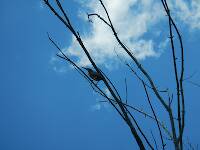
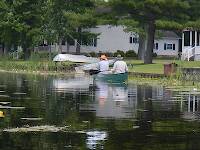
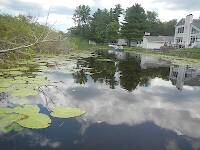
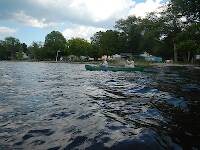
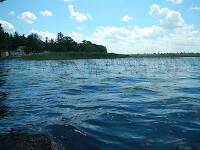
In the Photography Board by Jmd123
+ 15





In the Photography Board by Jmd123
8
Aug 8, 2019
by Jmd123
by Jmd123




